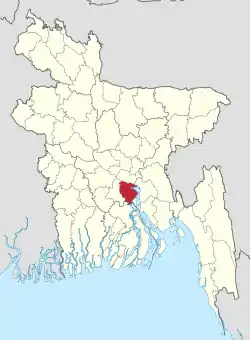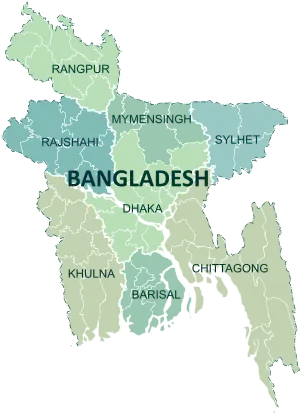Shariatpur
শরিয়তপুর | |
|---|---|
.jpg.webp)   .jpg.webp)  Clockwise from top-left: Sureshwar Darbar Sharif, trees in Shariatpur district, Manasa Temple in Shariatpur, Padma Bridge, Durga temple | |
 Location of Shariatpur in Bangladesh | |
Expandable map of Shariatpur | |
| Coordinates: 23°12.5′N 90°21′E / 23.2083°N 90.350°E | |
| Country | |
| Government | |
| • Deputy Commissioner | Md. Parvez Hasan |
| Area | |
| • Total | 1,174.05 km2 (453.30 sq mi) |
| Population (2022 census)[1] | |
| • Total | 1,294,562 |
| • Density | 1,100/km2 (2,900/sq mi) |
| Time zone | UTC+06:00 (BST) |
| Postal code | 8000 |
| HDI (2018) | 0.649[2] medium · 3rd of 21 |
| Website | www |
Shariatpur (Bengali: শরিয়তপুর জেলা, Shariatpur Jela also Shariatpur Zila) is a district in the Dhaka Division of central Bangladesh.[3]
History
Shariatpur was named after Haji Shariatullah (1781–1840), who was the founder of Faraizi Movement and an eminent Islamic reformer/revivalist during British Raj.[4] It was established as a district on 1 March 1984.[5]
In 1971 the Pak army in collaboration with their local agents conducted mass killing and plundering; they also set many houses of the district on fire. During Bangladesh Liberation War a number of encounters were held in Shariatpur Sadar Upazila between the freedom fighters and the Pak army in which about 313 Pak soldiers were killed. A number of freedom fighters were killed in two encounters and one frontal battle with the Pak army in Bhedarganj Upazila. Nine freedom fighters including Ahsanul Hoque and Abdul Wahab were killed in an encounter with the Pak army at a place on the southern side of Damudya College. Muktijoddha and Mujib Bahini jointly conducted attack on the Pak army by guerrilla technique in the upazila. Five freedom fighters were killed in an encounter with the Pak army in Gosairhat Upazila. The freedom fighters of Naria raided the Naria Police Station and captured all the arms and ammunitions of the thana. In retaliation, the Pak army sacked the nearby villages. During Bangladesh Liberation War a number of encounters were held between the freedom fighters and the Pak army in Zanjira Upazila in which a number of freedom fighters were killed.
Geography
Shariatpur District is bounded on the north by Munshiganj District, Barisal District on the south, Chandpur District on the east, Madaripur District on the west. Main rivers are Padma, Meghna, Palong, Jayanti, Kirtinasha, and Dharmaganj.[5]
Area of Shariatpur district is 1,181.53 km2 (456.19 sq mi).[5] It consists of 6 upazilas, 6 municipalities, 65 Union Parishad, 616 Mouza, 1243 villages, 213,677 households.[6]
Demography
| Year | Pop. | ±% p.a. |
|---|---|---|
| 1974 | 716,975 | — |
| 1981 | 845,662 | +2.39% |
| 1991 | 953,021 | +1.20% |
| 2001 | 1,082,300 | +1.28% |
| 2011 | 1,155,824 | +0.66% |
| 2022 | 1,294,562 | +1.04% |
| Sources:[1][7] | ||
According to the 2022 Census of Bangladesh, Shariatpur District had 308,964 households and a population of 1,294,562. The population density was 1,103 people per km2. Shariatpur district had a literacy rate (age 7 and over) of 72.90%, compared to the national average of 74.80%, and a sex ratio of 1083 females per 1000 males. 265,911 (20.54%) were under 10 years of age. 23.90% of the population lived in urban areas.[1]
| Religion | Population (1941)[8]: 100–101 | Percentage (1941) | Population (2022)[1] | Percentage (2022) |
|---|---|---|---|---|
| Islam |
490,991 | 76.77% | 1,251,474 | 96.67% |
| Hinduism |
148,551 | 23.23% | 42,721 | 3.30% |
| Others [lower-alpha 2] | 34 | 0.01% | 367 | 0.03% |
| Total Population | 639,576 | 100% | 1,294,562 | 100% |
Muslims make up 96.67% of the population, while Hindus are 3.30% of the population. The Muslim population has constantly increased while the Hindu population has stayed relatively constant.[1]
Administration
There are six upazilas (sub-districts) under this district,[9] namely:
Education
There are 772 primary schools, 19 lower secondary schools, 83 secondary schools and 42 Madrasas in Shariatpur. There are also 3 Public and 13 Private Colleges, 1 polytechnic Institute, 1 Vocational School and College, 1 Private University and one private medical college.[6]
Notable people
- T.M. Giasuddin Ahmed, former MP
- Shawkat Ali (politician)
- Iqbal Hossain Apu, MP
- K.M. Hemayet Ullah Auranga, politician
- Aminul Islam Biplob (cricketer)
- Khuda Buksh (1912–1974) regarded as father of insurance in Bangladesh
- Pulin Behari Das (revolutionary)
- Jogesh Chandra Ghosh (scholar, Ayurveda physician, entrepreneur and philanthropist)
- AKM Shahidul Haque (Former Inspector General of Police, Bangladesh)
- B.M Muzammel Haque, politician
- Farzana Islam, (academician)
- Geeta Dutt, Indian playback singer
- Sardar AKM Nasiruddin, former MP
- Kamrun Nesa Nilu, former MP
- Master Majibur Rahman, former MP
- Abdur Razzaq (former minister of water resources)
- Nahim Razzaq, MP
- AKM Enamul Haque Shamim, MP
- Siraj Sikder (politician)
- Abdul Haque Faridi (academic)
See also
Notes
- ↑ Palong, Bhedarganj, Gosairhat, Naria and Janjira thanas of Faridpur district
- ↑ Including Jainism, Christianity, Buddhism, Zoroastrianism, Judaism, Ad-Dharmis, or not stated
References
- 1 2 3 4 5 6 Population and Housing Census 2022 National Report (PDF). Vol. 1. Bangladesh Bureau of Statistics. November 2023.
- ↑ "Sub-national HDI - Area Database - Global Data Lab". hdi.globaldatalab.org. Retrieved 2020-03-18.
- ↑ "Shariatpur District". www.shariatpur.gov.bd. Retrieved 2023-03-30.
- ↑ Khan, Muin-ud-Din Ahmad (2012). "Shariatullah, Haji". In Islam, Sirajul; Jamal, Ahmed A. (eds.). Banglapedia: National Encyclopedia of Bangladesh (Second ed.). Asiatic Society of Bangladesh.
- 1 2 3 Shahidul Haque (2012). "Shariatpur District". In Sirajul Islam and Ahmed A. Jamal (ed.). Banglapedia: National Encyclopedia of Bangladesh (Second ed.). Asiatic Society of Bangladesh.
- 1 2 "Official Website". 12 March 2015. Retrieved 31 December 2016.
- ↑ "Bangladesh Population and Housing Census 2011 Zila Report – Shariatpur" (PDF). bbs.gov.bd. Bangladesh Bureau of Statistics.
- ↑ "Census of India, 1941 Volume VI Bengal Province" (PDF). Retrieved 13 August 2022.
- ↑ District Statistics 2011: Shariatpur (PDF), retrieved 23 February 2016
